![]() AndyWeather.com is a site I’ve maintained for about 10 years now. I use the site and related hardware, software, and services to test concepts and perform experiments.
AndyWeather.com is a site I’ve maintained for about 10 years now. I use the site and related hardware, software, and services to test concepts and perform experiments.
 I then apply my experience in delivering Internet of Things (IoT) solutions for Enterprise Data & Analytics customers and for SSIS and Biml training, such as my upcoming course titled Fundamentals of Azure Data Factory delivered in cooperation with Brent Ozar Unlimited.
I then apply my experience in delivering Internet of Things (IoT) solutions for Enterprise Data & Analytics customers and for SSIS and Biml training, such as my upcoming course titled Fundamentals of Azure Data Factory delivered in cooperation with Brent Ozar Unlimited.
It all started when GoDaddy created a DMZ for SQL Server databases. I found this functionality in 2008 and asked myself, “Self, how might we use this?”
Since That Time…
There have been two major iterations of AndyWeather. I use weather data collected during the first iteration for training purposes at SSIS Academy and when delivering training to Enterprise Data & Analytics customers.
AndyWeather v2
The setup of the second iteration is fairly straightforward:
- The Acurite Weather Station consists of an instrument pack plus a base station. The instruments collect weather measurements and transmit them to the base station.
- The base station is connected to an older e-Machine running Windows 7 Ultimate (32-bit) on 2GB RAM.
- An Acurite application interfaces with the base station and the application stores data locally in a single CSV file.
- I wrote a very simple C# console application named “abt” (an acronym for “Azure Blob Transfer”) to transfer the CSV file to Azure Blog Storage.
- An Azure Data Factory pipeline that loads an Azure SQL DB staging table.
- The AndyWeather website which reads the latest weather data from the Azure SQL DB staging table.
- I wrote another very simple C# application named “awt” (an acronym for “AndyWeather Tweets”) that tweets updates to the @AndyWeather twitter account.
Acurite Weather Station
The latest iteration began in early 2018 when I purchased an updated package of instruments and a new base station made by Acurite. So far, I like this station a lot. It was less expensive than the previous station and appears more rugged (again, so far – time will tell).
I recently relocated the weather station to improve connectivity between the instruments and the base station. I recorded a Data Driven *DataPoint* about it:
(Pay no attention to the exploding pecans in the background…)
The e-Machine
I intentionally use an under-powered PC for the server. Why? I want to learn how the base station – and then everything downstream of the base station – responds to busy server conditions. This is Engineering 101 stuff and I’ve learned a lot:
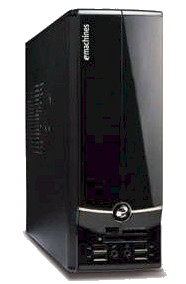
I love this old machine!
Acurite Application
The Acurite people maintain an application for communicating with base stations:
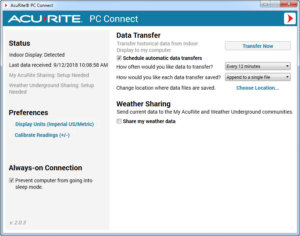
The PC Connect application allows me to configure how and when weather data is collected from the base station – which collects measurements from the instruments. The application lets me configure the units-of-measure and file location – and I can even share my weather data with Weather Underground. How cool is that?
The Azure Blob Transfer Console Application
The Azure Blob Transfer (abt) application is a very simple console application written in C#. It picks up the CSV file containing weather data stored by the Acurite PC Connect application and writes the file to an Azure Blob Storage container:

The CSV file in Azure Blob Storage is overwritten each time abt successfully executes. You can download a copy of the abt solution here.
Azure Data Factory Pipeline
An Azure Data Factory (ADF) pipeline calls a stored procedure that first truncates a staging table in a Azure SQL DB using a Stored Procedure activity, followed by a Copy Data activity that copies the weather data from the CSV file in Azure Blob Storage to an Azure SQL DB staging table:
At the time of this writing, ADF version 2 is current.
You can download the ARM template for the pipeline here.
The AndyWeather Website
The AndyWeather website has been around since the days of the first iteration of AndyWeather – the one that stored data in a SQL Server instance hosted at GoDaddy’s DMZ. It’s fairly straightforward code, which helps it perform fairly on desktops and mobile devices:
The biggest performance hit comes from executing the stored procedure against an Azure SQL DB, which can sometimes take 5-10 seconds to complete.
The AndyWeather Tweets Console Application
Note: Twitter switched off TLS 1.0 and 1.1 in July 2019. The code has been updated to reflect Twitter’s TLS 1.2 requirement.
I snagged some C# code and a TwitterAPI class from a project named called TweetSharp to help build the awt console application:
You can download a copy of the awt solution here.
The @AndyWeather Twitter Account
It makes me happy every time I see a tweet from @AndyWeather:
I tell people, “It’s just a dumb little app,” but I really had fun building it. I learned a bunch, too!
Conclusion
The AndyWeather IoT solution uses hybrid technology – on-premises instruments and servers, combined with cloud services – to deliver weather data to a website and Twitter account. It’s accessible from social media and the web from desktops and mobile devices.
Just so you know, this isn’t everything I’ve built using the AndyWeather instruments. There’s a bunch more – some of which is still in the experimental phase. I’ll share more as time permits. But I want you all to know, I consider Azure a great big cyber-playground!
:{>


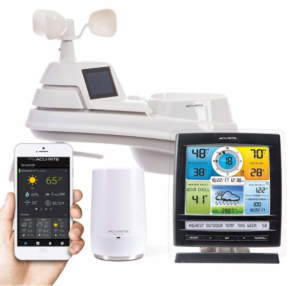

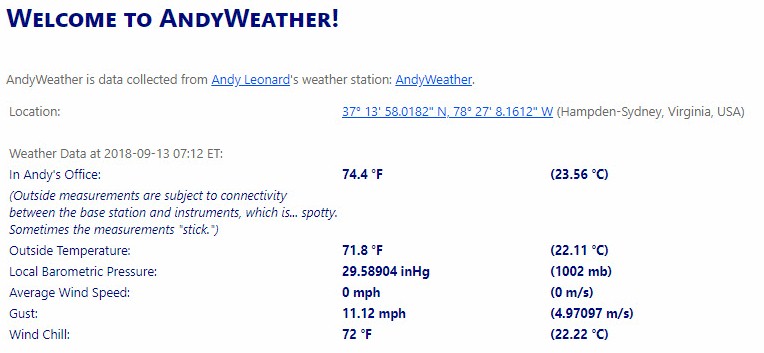

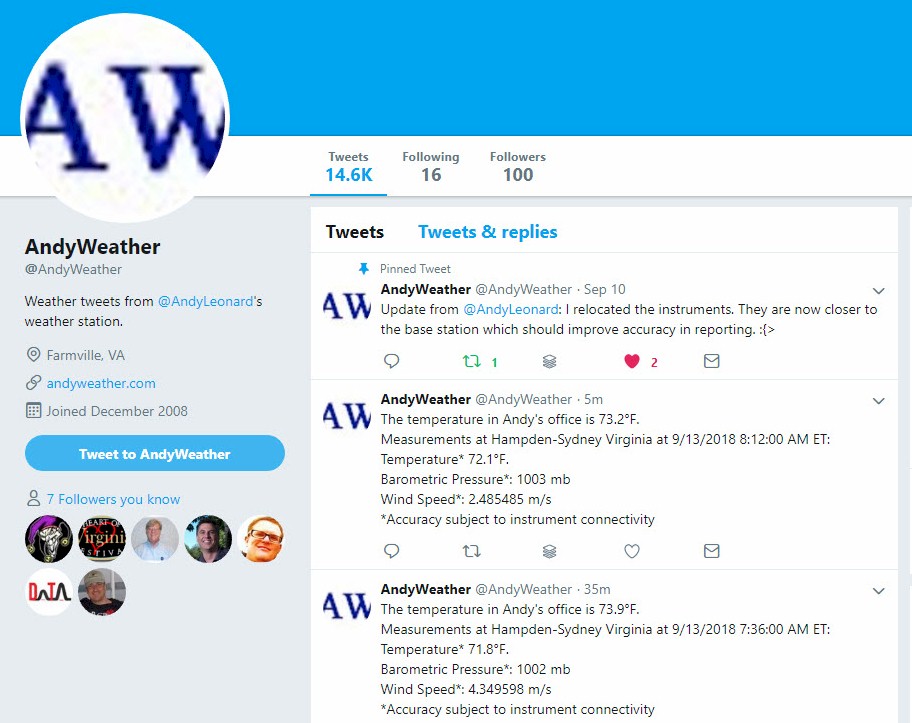
One thought on “AndyWeather Internet of Things (IoT)”